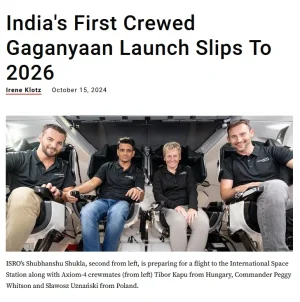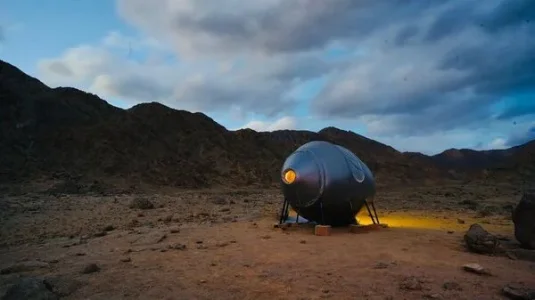- Joined
- Jul 6, 2024
- Messages
- 504
- Likes
- 3,482
@Indx TechStyle I think it's time for a dedicated thread for our spacestationBAS base module interiors (to be launched in 2028)
View attachment 11637
Gaganyaan-H2 mission with indigenous IVA suit
View attachment 11638
All missions precursor to BAS
View attachment 11639
View attachment 11640
There is one already.@Indx TechStyle I think it's time for a dedicated thread for our spacestation
Please tranfer these to that threadThere is one already.
View: https://x.com/TitaniumSV5/status/1746737267203621212
Tender Document https://eproc.vssc.gov.in/common/vi...300022301&id=ff8081818c6d2b13018caf540fb61586
1/n (Gaganyaan ECLSS tender document)Environmental Control and Life Support System (ECLSS) consists of:Thermal & Humidity Control System (THCS) Cabin Pressure Control System (CPCS) Air Revitalization & Trace Contaminant Control System (ARS)ECLSS Control system #ISRO
2/n The Environment control and life control system has to cater to 3 crew for 7-day mission. The cabin specifications considering the human physiological requirements and comfort are as follows:
3/n Schematic of the ECLSS system:
4/n Total volume of Gaganyaan crew module cabin is 6.7㎥.Cabin air volume is 4.8㎥.Optimal cabin temperature - 23 ± 3˚C (prechilled to 18 ˚C before ascent and deboost)Relative humidity - 30-70%Nominal cabin pressure - 101kPa
View attachment 9378
5/n ECLSS duty cycle duration rating -In-orbit - 7 days Pre-launch - 2.5hoursAscent to orbit - 20min Descent from orbit - 50min Emergency time safety margin:In-orbit - 130min Descent - 50min Total - 180min
6/n Open loop ECLSS for a duration up to 7 days supporting 3 crew for LEO orbit of 400 km. System shall be modular which can be scaled for different mission duration 3-7 days and number of crews from 1-3.
7/n Crew activities required for ECLSS functioning:
8/n Redundancy in systems including crew intervention.System which will generate O2 and remove CO2 in case Cabin Ventilation Unit (CVU) is not operational.
9/n Triple redundancy with FDI and re-configuration logic for sensors and electronics – Detailed FDI algorithm shall be generated.Provision for crew override/manual operation for mechanical systems. Provide real time display/warnings to crew about critical parameters.
10/n Thermal and Humidity Control System (THCS):Maintain thermal conditioning of the CM so as to ensure crew health and comfort and to ensure that all systems/ equipment can be maintained within their operating temperature envelopes by removing or adding sensible heat.
11/n The main function of cabin thermal control system is to maintain the cabin temperature within 23± 3C (Nominal) and relative humidity 30 to 70%. The equipment temperature shall be maintained using cold plate. Electronic equipment mounted on the cold plate<45°C)
12/n It shall be able to accept thermal energy from crew and components(includes electronic components, pumps, heat exchangers, fans & cold plates).Transport the thermal energy from heat source (CM) to heat sink (SM radiators) using close loop mechanically pumped system.

Lol, It will be by 2028Gaganyaan H1 slips to 2026
View attachment 12592
India's First Crewed Gaganyaan Launch Slips To 2026 | Aviation Week Network
India now expects the first crewed flight of its Gaganyaan spacecraft to launch in 2026, following a trio of uncrewed flight tests slated to begin next year.aviationweek.com
Lol, It will be by 2028
If you believe articles you will be forced to take large amount of copium, be realistic, H1 won't be before 2028.The article says that the 8 Gaganyaan missions including the BAS-1 will be completed by Dec 2028.
I don't think the H1 mission will be delayed beyond 2026.
If you believe articles you will be forced to take large amount of copium, be realistic, H1 won't be before 2028.
All 8 missions will be completed only by 2030
G1 & TV-D2 ,PAT-02, IDRSS-1 - 2025
G2,TV-A1, IDRSS-2 - 2026
G3, TV-A2 -2027
H1, , -2028
G4,BAS-1, -2029
G5,H2 - 2030
If you believe articles you will be forced to take large amount of copium, be realistic, H1 won't be before 2028.
All 8 missions will be completed only by 2030
G1 & TV-D2 ,PAT-02, IDRSS-1 - 2025
G2,TV-A1, IDRSS-2 - 2026
G3, TV-A2 -2027
H1, , -2028
G4,BAS-1, -2029
G5,H2 - 2030
They did ,but even after that it will take time, HSF is not easy....only recently they have decided to make the pressurised crew module at HAL, before that they were discussing with goras to import itI was watching Dr. Somnath's interview. He said that ISRO has prioritized Gaganyaan over everything else.This explains why we had so few launches this year.
but maybe,you're right...ISRO has a historical tendency to give unrealistic timelines.
Also what I have said is most realistic, I gave 1 year gap between each missionI was watching Dr. Somnath's interview. He said that ISRO has prioritized Gaganyaan over everything else.This explains why we had so few launches this year.
but maybe,you're right...ISRO has a historical tendency to give unrealistic timelines.
We knew it had to be so. With first unammned flight in 2024, there is no way human spaceflight would happen before 2026.Gaganyaan H1 slips to 2026
View attachment 12592
India's First Crewed Gaganyaan Launch Slips To 2026 | Aviation Week Network
India now expects the first crewed flight of its Gaganyaan spacecraft to launch in 2026, following a trio of uncrewed flight tests slated to begin next year.aviationweek.com

